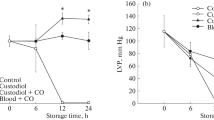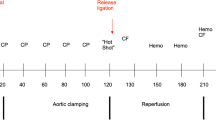Abstract
The effects of 6-h hypothermic cardioplegic arrest on myocardial biochemical, morphologic, and functional recovery were investigated in two groups of dogs. Group 1 (n = 6) was subjected to hypothermia of 15°C and group 2 (n = 6) was subjected hypothermia of 5°C. Although the myocardial calcium (Ca) concentration was significantly higher at the end of reperfusion in group 2 compared to group 1, the MB-fraction of creatine kinase, mitochondrial aspartate aminotransferase, recovery of left ventricular systolic function, and mitochondrial morphologic integrity were better in group 2 than in group 1. These findings suggest that hypothermia of 5°C in 6-h cardioplegia is not necessarily coupled with interference in myocardial contractility, despite the Ca overload that occurs during reperfusion.
Similar content being viewed by others
References
Kao RL, Conti VR, Williams EH (1982) Effect of temperature during potassium arrest on myocardial metabolism and function. J Thorac Cardiovasc Surg 84:243–249
Rosenfeldt FL (1982) The relationship between myocardial temperature and recovery after experimental cardioplegic arrest. J Thorac Cardiovasc Surg 84:656–666
Bretschneider HJ (1980) Myocardial protection. J Thorac Cardiovasc Surg 28:295–302
Martin DR, Scott DF, Downer GL, Belzer FO (1972) Primary cause of unsuccessful liver and heart preservation: Cold sensitivity of the ATPase system. Ann Surg 175:111–117
McMurchie EJ, Raison JK, Cairncross KD (1973) Temperature-induced phase changes in membranes of heart: A contrast between the thermal response of poikilotherms and homeootherms. Comp Biochem Physiol 44(B):1017–1026
Kurihara S, Sakai T (1985) Effect of rapid cooling on mechanical and electrical responses in ventricular muscle of the guinea pig. J Physiol 361:361–378
Lyons JM, Raison JK (1970) A temperature-induced transition in mitochondrial oxidation: Contrast between cold and warm blooded animals. Comp Biochem Physiol 37:405–411
Magovern CJ Jr, Flaherty JT, Gott VL, Bulkley BH, Gardner TJ (1982) Failure of blood cardioplegia to protect myocardium at lower temperatures. Circulation 66:160–167
Coraboeuf E, Weidman S (1954) Temperature effects on the electrical activity of Purkinje fibres. Helv Physiol Pharmacol Acta 12:32–41
Rousou JH, Dobbs WA, Meeram MK, Engelman RM (1982) The temperature-dependence of recovery of metabolic function following hypothermic potassium cardioplegic arrest. J Thorac Cardiovasc Surg 83:117–121
Hearse DJ (1991) Reperfusion-induced injury: A possible role for oxidant stress and its manipulation. Cardiovasc Drugs Ther 5:225–236
Sunamori M, Trout RG, Kaye MP, Harrison CE Jr (1978) Quantitative evaluation of myocardial ultrastructure following hypothermic anoxic arrest. J Thorac Cardiovasc Surg 76: 518–527
Bigelow WG, Lindsay WK, Harrison RC, Gordon RA, Greenwood WF (1950) Oxygen transport and utilization in dogs at low body temperature. Am J Physiol 160:125–130
Lee JC (1965) Effect of hypothermia on myocardial metabolism. Am J Physiol 208:1253–1258
Flaherty JT, Schaff HV, Goldman RA, Gott VL (1979) Metabolic and functional effects of progressive degrees of hypothermia during global ischemia. Am J Physiol 236:H839-H845
Fuhrman GJ, Fuhrman FA, Field J (1950) Metabolism of rat heart slices with special reference to effects of temperature and anoxia. Am J Physiol 163:642–647
Rosenfeldt FL, Hearse DJ, Cankovic-Darracott S, Braimbridge MV (1980) The additive protective effects of hypothermia and chemical cardioplegia during ischemic cardiac arrest in the dog. J Thorac Cardiovasc Surg 79:29–38
Hearse DJ, Stewart DA, Braimbridge MV (1980) The additive protective effects of hypothermia and chemical cardioplegia during ischemic cardiac arrest in the rat. J Thorac Cardiovasc Surg 79:39–43
Frank JS, Rick TL, Beydler S, Kreman M (1982) Calcium depletion in rabbit myocardium: Ultrastructure of the sarcolemma and correlation with the calcium paradox. Circ Res 51:117–130
Tyers GFO, Williams EH, Hughes HC, Todd GJ (1977) Effects of perfusion temperature on myocardial protection from ischemia. J Thorac Cardiovasc Surg 73:766–771
Alto LE, Dhalla NS (1979) Myocardial cation contents during induction of calcium paradox. Am J Physiol 237:H13-H19
Leaf A (1973) Cell swelling. A factor in ischemic tissue injury. Circulation 48:455–458
Macknight AC, Leaf A (1977) Regulation of cellular volume. Physiol Rev 57:510–573
Stemmer EA, Joy I, Aronow WS, Thibault W, McCart P, Connolly JE (1975) Preservation of myocardial ultrastructure. J Thorac Cardiovasc Surg 70:666–676
Opie LH (1991) Role of calcium and other ions in reperfusion injury. Cardiovasc Drug Ther 5:237–248
Caroni P, Carafoli E (1980) An ATP-dependent Ca-pumping system in dog heart sarcolemma. Nature 283:765–767
Mattiazi A, Nison E (1976) The influence of temperature on the tissue course of the mechanical activity in rabbit papillary muscle. Acta Physiol Scand 97:310–318
Sunamori M, Sultan I, Shirai T, Suzuki A (1992) The significant role of membrane stabilization in hypothermic cardioplegic cardiac preservation in a canine experimental model. Transplant Int 5[Suppl 1]:5411–5416
Miyamoto H, Sunamori M, Suzuki A (1993) Comparison of intermittent injection of nondepolarizing solution with a single flush of UW solution for donor heart preservation. Transplant Int 6:63–68
Author information
Authors and Affiliations
Rights and permissions
About this article
Cite this article
Sunamori, M., Amano, J. & Suzuki, A. The effects of a temperature below 15°C on the myocardial calcium and ultrastructure in donor heart preservation in a canine model. Surg Today 24, 809–814 (1994). https://doi.org/10.1007/BF01636311
Received:
Accepted:
Issue Date:
DOI: https://doi.org/10.1007/BF01636311




